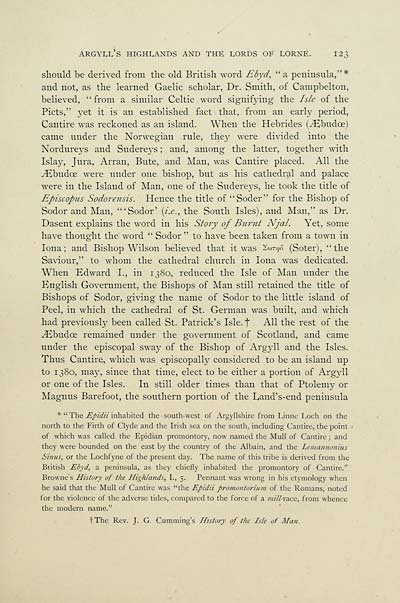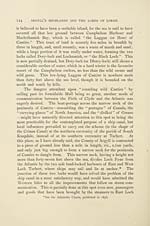Download files
Complete book:
Individual page:
Thumbnail gallery: Grid view | List view

Argyll's highlands and the lords of lorne. 123
should be derived from the old British word Ebyd, " a peninsula,"*
and not, as the learned Gaelic scholar, Dr. Smith, of Campbelton,
believed, "from a similar Celtic word signifying the Isle of the
Picts," yet it is an established fact that, from an early period,
Cantire was reckoned as an island. When the Hebrides (^Ebudce)
came under the Norwegian rule, the}' were divided into the
Nordureys and Suderej-s ; and, among the latter, together with
Islay, Jura, Arrau, Bute, and Man, was Cantire placed. All the
^Ebudce were under one bishop, but as his cathedral and palace
were in the Island of Man, one of the Sudereys, he took the title of
Episcopus Sodorensis. Hence the title of "Soder" for the Bishop of
Sodor and Man, "'Sodor' {i.e., the South Isles), and Man," as Dr.
Dasent explains the word in his Story of Burnt Njal. Yet, some
have thought the word " Sodor" to have been taken from a town in
Ioua ; and Bishop Wilson believed that it was SuttjS (Soter), "the
Saviour," to whom the cathedral church in Iona was dedicated.
When Edward I., in 1380, reduced the Isle of Man under the
English Government, the Bishops of Man still retained the title of
Bishops of Sodor, giving the name of Sodor to the little island of
Peel, in which the cathedral of St. German was built, and which
had previously been called St. Patrick's Isle.t All the rest of the
^Ebudce remained under the government of Scotland, and came
under the episcopal swaj' of the Bishop of Argyll and the Isles.
Thus Cantire, which was episcopally considered to be an island up
to 1380, may, since that time, elect to be either a portion of Argyll
or one of the Isles. In still older times than that of Ptolemy or
Magnus Barefoot, the southern portion of the Dand's-end peninsula
* " The Epidii inhabited the south-west of Argyllshire from Linne Loch on the
north to the Firth of Clyde and the Irish sea on the south, including Cantire, the point
of which was called the Epidian promontory, now named the Mull of Cantire ; and
they were bounded on the east by the country of the Albain, and the Lema?tnonius
Sinus, or the Lochfyne of the present day. The name of this tribe is derived from the
British Ebyd, a peninsula, as they chiefly inhabited the promontory of Cantire."
Browne's History of the Highlands, I., 5. Pennant was wrong in his etymology when
he said that the Mull of Cantire was "the Epidii promontorium of the Romans, noted
for the violence of the adverse tides, compared to the force of a mill-xa.ce, from whence
the modern name."
tThe Rev. J. G. Cumming's History of the Isle of Man.
should be derived from the old British word Ebyd, " a peninsula,"*
and not, as the learned Gaelic scholar, Dr. Smith, of Campbelton,
believed, "from a similar Celtic word signifying the Isle of the
Picts," yet it is an established fact that, from an early period,
Cantire was reckoned as an island. When the Hebrides (^Ebudce)
came under the Norwegian rule, the}' were divided into the
Nordureys and Suderej-s ; and, among the latter, together with
Islay, Jura, Arrau, Bute, and Man, was Cantire placed. All the
^Ebudce were under one bishop, but as his cathedral and palace
were in the Island of Man, one of the Sudereys, he took the title of
Episcopus Sodorensis. Hence the title of "Soder" for the Bishop of
Sodor and Man, "'Sodor' {i.e., the South Isles), and Man," as Dr.
Dasent explains the word in his Story of Burnt Njal. Yet, some
have thought the word " Sodor" to have been taken from a town in
Ioua ; and Bishop Wilson believed that it was SuttjS (Soter), "the
Saviour," to whom the cathedral church in Iona was dedicated.
When Edward I., in 1380, reduced the Isle of Man under the
English Government, the Bishops of Man still retained the title of
Bishops of Sodor, giving the name of Sodor to the little island of
Peel, in which the cathedral of St. German was built, and which
had previously been called St. Patrick's Isle.t All the rest of the
^Ebudce remained under the government of Scotland, and came
under the episcopal swaj' of the Bishop of Argyll and the Isles.
Thus Cantire, which was episcopally considered to be an island up
to 1380, may, since that time, elect to be either a portion of Argyll
or one of the Isles. In still older times than that of Ptolemy or
Magnus Barefoot, the southern portion of the Dand's-end peninsula
* " The Epidii inhabited the south-west of Argyllshire from Linne Loch on the
north to the Firth of Clyde and the Irish sea on the south, including Cantire, the point
of which was called the Epidian promontory, now named the Mull of Cantire ; and
they were bounded on the east by the country of the Albain, and the Lema?tnonius
Sinus, or the Lochfyne of the present day. The name of this tribe is derived from the
British Ebyd, a peninsula, as they chiefly inhabited the promontory of Cantire."
Browne's History of the Highlands, I., 5. Pennant was wrong in his etymology when
he said that the Mull of Cantire was "the Epidii promontorium of the Romans, noted
for the violence of the adverse tides, compared to the force of a mill-xa.ce, from whence
the modern name."
tThe Rev. J. G. Cumming's History of the Isle of Man.
Set display mode to:
![]() Universal Viewer |
Universal Viewer | ![]() Mirador |
Large image | Transcription
Mirador |
Large image | Transcription
Images and transcriptions on this page, including medium image downloads, may be used under the Creative Commons Attribution 4.0 International Licence unless otherwise stated. ![]()
| Histories of Scottish families > Argyll's Highlands, or, MacCailein Mor and the Lords of Lorne > (143) Page 123 |
|---|
| Permanent URL | https://digital.nls.uk/95003578 |
|---|
| Description | A selection of almost 400 printed items relating to the history of Scottish families, mostly dating from the 19th and early 20th centuries. Includes memoirs, genealogies and clan histories, with a few produced by emigrant families. The earliest family history goes back to AD 916. |
|---|

